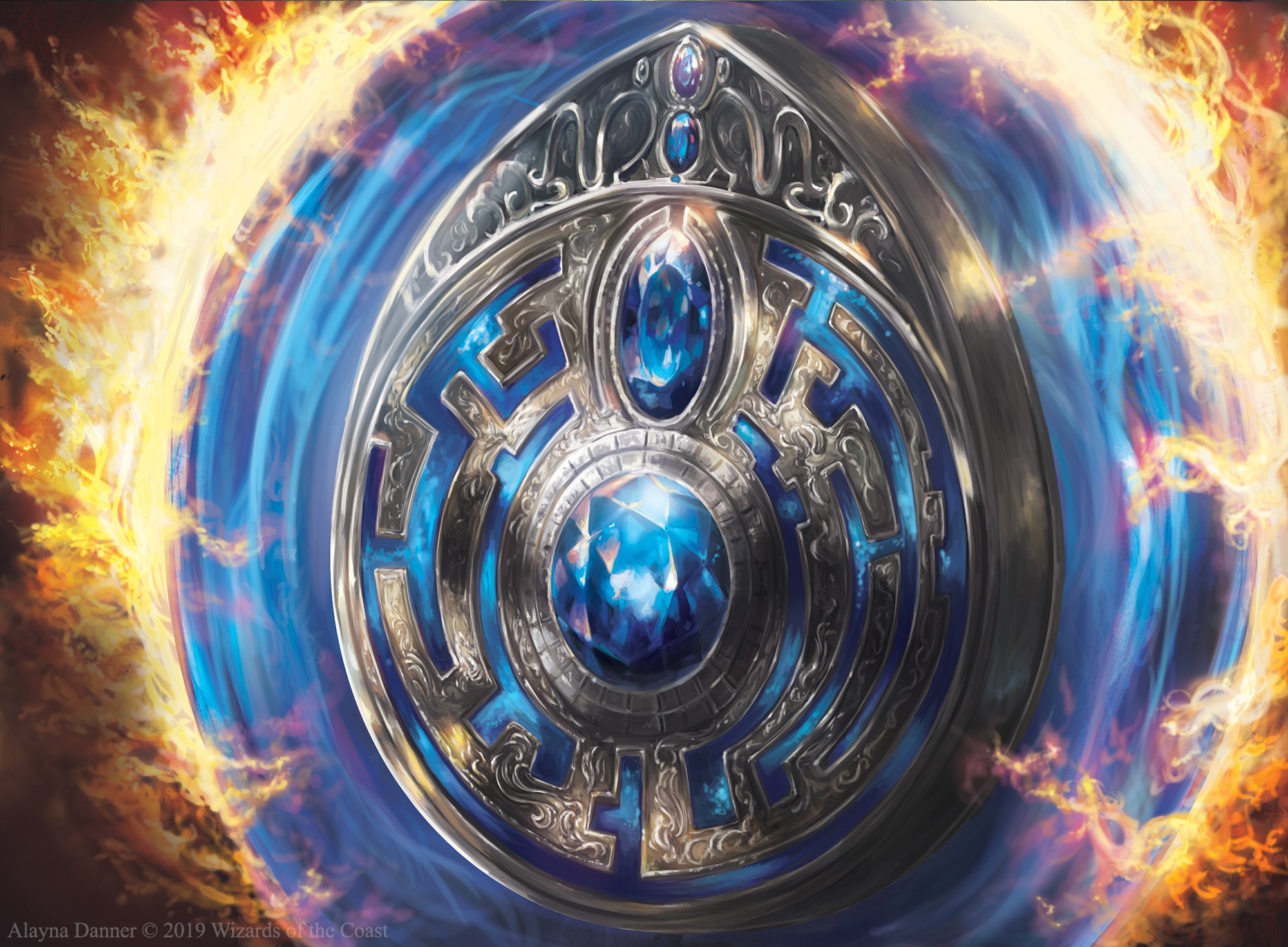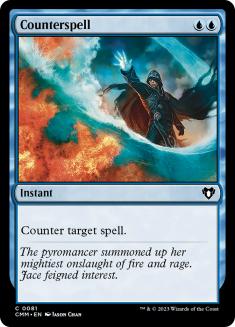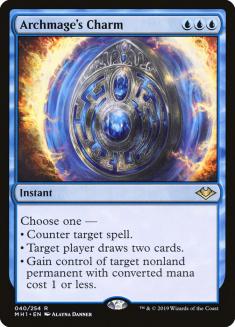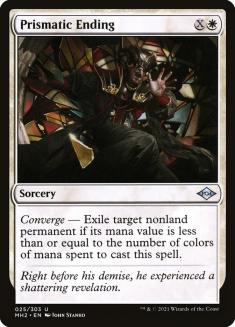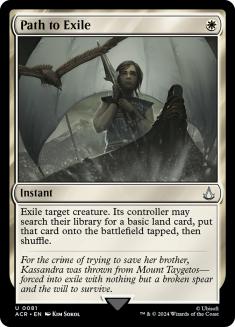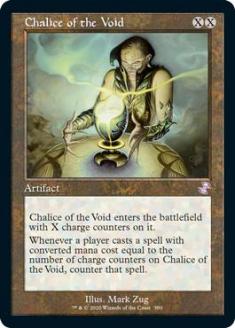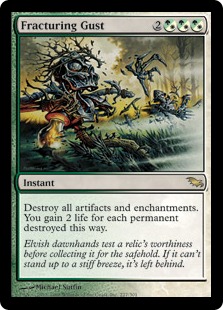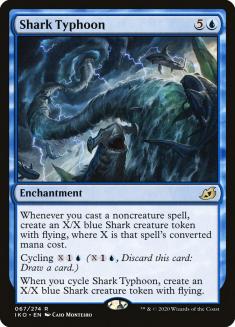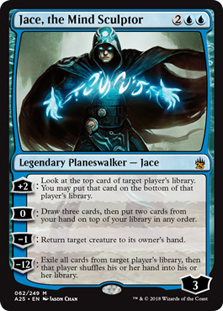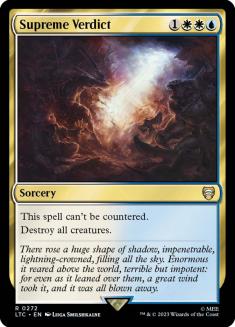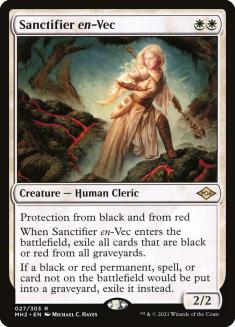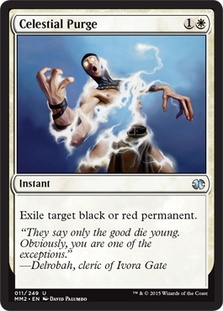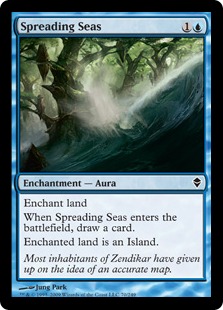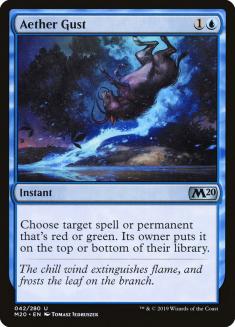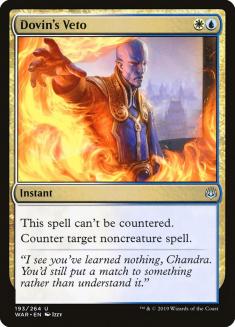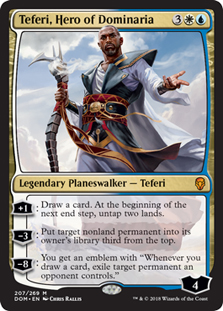With paper Magic back in some capacity, there’s no shortage of Modern results to sift through for data. I am continuously updating Azorius and Esper Control in the format, to tackle the latest fads, while staying competitive against the classics. Modern keeps a sizable portion of its metagame static, especially with in-person events. Not everyone has the resources, or the desire, to pitch their favorite deck in favor of the new hotness. Players, myself included, fall in love with an archetype and have a difficult time letting it go. Even in the darkest times, we find solace casting that one spell, going off with that one combo, or dropping that one brutally powerful creature, regardless of their current position in the competitive pecking order.
It’s no secret that I fancy myself a control mage and have consistently played Azorius Control (Kaheera) since the format’s inception. I have gone rogue with some combo here and there; however, I always return to the Celestial Colonnade. Azorius Control has had the tools to take down foes since the format came out and that shell didn’t change much over the years. With the release of some Modern-only sets, designed to ramp up the power level, the game has changed.
Azorius Control is hardly recognizable by card title, but the effects are very similar. Instead of helplessly grasping at the opponent’s spells with Mana Leak and Logic Knot, the current deck torpedoes them with Counterspell and Archmage’s Charm. There was a time when Cryptic Command was the gold standard, and now there are none on the leaderboards. I gave a desperate attempt to keep it on the team at the last SCG Invitational, but now it’s time to put down the expensive reactive spell for more contemporary options.
The deck hasn’t changed much since my third-place run at the SCG Invitational in late October. The beauty of current Azorius Control is the power level of the reactive spells. Nothing is beating Counterspell and Prismatic Ending in the foreseeable future of Modern. Counterspell has survived the test of time, while most of its counterparts have fallen into unplayable purgatory. It was yawned at by many when reprinted, but those who have it framed above their mantel at home knew the truth. This piece of disruption is revolutionary and has become a format staple in Modern, with little chance of ever being replaced or removed.
Prismatic Ending is not a reprint, but it did eliminate all its competition in the removal department. Path to Exile was the flagbearer since the start, yet fell easily once Prismatic Ending arrived. There were some unique takes on control, with four Chalice of the Void and zero Path to Exile, a while back, but they were unsuccessful ventures. The current Azorius Control shell is rock-solid without the assistance of many of the older staples. I accepted the fate of Path to Exile, and had great success without it, but I think cutting the cord on it completely was done in haste.
There are far too many top decks that leverage a Turn 1 Ragavan, Nimble Pilferer to be fully dependent on one removal spell. When on the draw, it is Solitude or bust in many situations in the current metagame. I have never been a fan of that blind side of Azorius Control, because things were similarly difficult then. The punishment was not always game over, like with Ragavan; however, the lack of Turn 1 interaction hurt the control team time after time. The ejection of Path to Exile was due to the power of Solitude and Prismatic Ending, eliminating the need for the third best creature response. It turns out that having a fifth removal spell on the draw is a necessary evolution of the archetype to respond to the current metagame.
The obvious reason we all ditched Path to Exile was due to the inclusion of Chalice of the Void. Dropping it onto the battlefield with one counter disincentivizes playing one-mana spells. I agreed with that premise then and still do today. We’re far from an Azorius Control deck with Consider and Snapcaster Mage back in the lineup; however, playing one copy of a possible dead card is not back-breaking. There are only two copies of Chalice of the Void, making the risk low for the one-of Path to Exile.
Another defense to this addition is the state of the match when this discouraging situation arises. Decks that get hit by an enemy Chalice of the Void are in big trouble, as it locks down a huge portion of most of the metagame. When that occurs, drawing an uncastable Path to Exile does negligible harm. Even if drawn and needed, it being another white spell that can be pitched to Solitude makes it not as dead as it looks on paper. Having two copies of Chalice of the Void isn’t enough to make a single Path to Exile cataclysmic, and its utility in a creature-filled metagame is too good to pass up.
The rest of the deck has undergone some minor changes to the manabase and a revamping of the sideboard to address the metagame shifts I’ve seen. Having to add Fracturing Gust back to the sideboard was the only depressing modification, since that card is dead against everything outside of Mono-White Hammer (Lurrus). The matchup is so close that it felt like a necessary change, especially with its consistently high finishes in both paper and digital Magic.
The strength of the Azorius Control sideboard is the wide application of its spells, with each handling multiple decks in the format. Cards like Mystical Dispute, Aether Gust, Celestial Purge, Sanctifier en-Vec, and Chalice of the Void have helped solidify the wide net that control can cast on the competitive metagame lineup. Even though many of these are self-explanatory, I would like to provide my readers with some guidance against a few of the top decks that are tricky to sideboard against.
VS Grixis Death’s Shadow (Lurrus)
Out:
In:
The matchup against Grixis Death’s Shadow (Lurrus) has changed quite a bit over the years. The gameplay between these two decks is legendary and is among my favorites. Azorius Control has typically come out ahead in the past, on the back of its removal and inherent card advantage it produces. The hand disruption that Grixis Death’s Shadow (Lurrus) pumped out then didn’t produce a deadly permanent soon after. Death’s Shadow was typically a Turn 3 or Turn 4 card, which allowed some flexibility in how control players could respond. Now, it leverages the threat of an early-game Ragavan, making the matchup not as clean as it used to be.
Luckily, the newer versions don’t have a bunch of blue disruption, like it did in the old days. Getting your primary spells countered by Stubborn Denial felt terrible, which Grixis Death’s Shadow (Lurrus) currently doesn’t do as often. You see a little Spell Pierce here and there, but nothing as scary as the original disruption. It leans completely on Drown in the Loch now, a spell that can be mitigated more easily. Removing graveyards with Rest in Peace and playing around two open mana are common lines of play that make Drown in the Loch much less scary than the one-mana equivalents of old.
Since this is really the only countermagic, the sideboarded games do not include Mystical Dispute. All the black and red, graveyard, and cheap-spell hate comes in, while removing some of the more expensive cards of Azorius Control. Getting lean in the sideboarded games is essential to handling the onslaught of hand disruption and problematic creatures in the early-game.
VS Orzhov Hammer (Lurrus)
Out:
In:
Orzhov Hammer (Lurrus) is one of those decks that can draft a series of unbeatable plays, regardless of the disruption drawn. It’s the combo deck of the format, disguised as a Mono-White beatdown deck. It uses irritating creatures in the early-game, only to hit for a million and/or infect you into oblivion on the drop of a dime. Where this deck falls short is its consistency, often going down the path of a Mono-White Aggro deck, which is an unimpressive look in a format as powerful as Modern.
I give some legitimacy to the deck with my inclusion of Fracturing Gust. This spell is a house against them and dead against the rest of the field. It’s one of those spells that can be set up when drawn, picking off the targets that are unaffected by the massive artifact destruction before letting it rip. It’s only a one-of though, which is why the heavy removal, three copies of Chalice of the Void, and the lack of expensive spells in sideboarded games are so vital.
VS Four-Color Blink (Yorion)
Out:
In:
This is one of the tougher matchups that Azorius Control runs into. Four-Color Blink (Yorion) has grown in popularity over the last few weeks, in paper and digital, prompting a sideboard redesign. The matchup is tough because of the tremendous value the deck generates and I pay the price for gearing the maindeck to have more early-game defense. Countermagic, Shark Typhoon, and planeswalkers are how you win this matchup, which is tough to manage Game 1. Between all the Spreading Seas and the pile of removal spells, it takes a ton of finesse to escape with an early win. The sideboarded games favor Azorius Control, as those dead cards are replaced by some of my favorite pieces of disruption that the format can offer.
Aether Gust, Celestial Purge, Mystical Dispute, Dovin’s Veto, and one more Shark Typhoon come to save the day in this challenging matchup. There are alternatives I could play that shut down all enter the battlefield nonsense; however, that’s another strike against the strength control wields with this current build. Maintaining a sideboard with cards that hit multiple matchups is a must, especially with options this powerful. Each card has reach in other matchups while making this one manageable. Although this matchup can be tough overall, it is winnable and entertaining, especially with sideboard assistance.
VS Sultai Infect
Out:
In:
The matchup against Sultai Infect is surprisingly good. There are some scary, explosive starts it can produce, but the disruption we’re packing is well-equipped to handle it. The threats it produces are targeted in the early-game by Prismatic Ending, with Solitude as a fallback. If something does survive due to their protection spells, Supreme Verdict can handle what’s left. Against my old nemesis Inkmoth Nexus, Azorius Control packs four copies of Spreading Seas and a Field of Ruin, making it not as fearsome as it once was. But the best card in this matchup, hands down, is Teferi, Time Raveler.
All their interaction is completely squashed by an active Teferi. No amount of Spell Pierce, Blossoming Defense, Vines of Vastwood, or Veil of Summer will save them from that planeswalker. In a close second, Chalice of the Void on one is a crushing play against Sultai Infect. That’s often the counter-play after their first or second turn. The only silver bullet they have against us is Phyrexian Crusader. This is a tricky threat to navigate and requires very specific answers from the control side. Supreme Verdict is one of the few ways to handle a resolved one, but luckily we have ample counterspells that all have Phyrexian Crusader’s name on them. That threat is scary, but the overall matchup is in control’s favor.
VS Azorius Control (Kaheera)
Out:
In:
The mirror can be more difficult with this build, since the emphasis has shifted to defeating the faster decks of the format. I’m not packing as many copies of Dovin’s Veto as most folks, but my win percentage is still quite strong against them. The number of anti-control cards isn’t as important as the gameplay, making sure that each spell you combat is vital. Far too often I see my control brethren throw an arsenal at card draw, even cantrips, in an effort to force a stumble. The games go too long in the mirror and all resources must be used to their fullest, especially when playing as few weapons as we are in this build.
Although there are fewer blue disruption spells, the Shark Typhoon count is still high. Playing three copies, when some decks are playing just one or two, is a huge boost to our control matchup percentages. I win many of my mirror matches with a hard-cast Shark Typhoon, after the disruption battle on the previous turn. This is typically game over and clean. The opposing player must use every resource they command to remove it, but it’s often far too late at that point.
VS Amulet Titan
Out:
In:
The Amulet Titan matchup has been consistently improving over the last few years. When Field of the Dead was legal, it was close to unwinnable for control, but now that it’s gone and we have more weapons, the ball is back in our court. Prismatic Ending gives control a way to remove an early Amulet of Vigor and the counterspells are much deadlier now against the green ramp decks. One of the biggest sleepers is Chalice of the Void. I have crushed Amulet Titan players with a Chalice of the Void set to one prior to their Amulet of Vigor resolving, but also unleashing one set to zero to lock out the threat of Summoner’s Pact.
The sideboarded games are similar to Game 1, with the exciting edition of Aether Gust. Aether Gust has been a thorn in the side of Amulet Titan since it was released, getting around Cavern of Souls and hitting each powerful threat that the deck can produce is the exact effect needed to put control over the edge. With Field of Ruin, Spreading Seas, blue disruption, powerful white removal, and early Chalice of the Void-setting, this is one matchup that I look forward to having.
Control With Confidence
There are many decks in the Modern multiverse that spike victories with each passing week. In the recent NRG Series: Milwaukee, Sultai Infect claimed victory. That’s another event that influenced the inclusion of Path to Exile, even though it’s unlikely to reoccur anytime soon. The strength of Teferi, Time Raveler against a deck like Sultai Infect, Temur Cascade, the mirror, and anything that uses the stack is through the roof. Counterspell, Prismatic Ending, and Solitude may have put Azorius Control back on top, but Teferi, Time Raveler cleans up the riffraff in the metagame. Older all-stars like Amulet Titan, Hardened Scales, Dredge, and Boros Burn run into a brick wall of powered-up disruption that they have difficulty overcoming.
With Teferi keeping the broken decks at bay and the newer additions handling the resurgent decks of old, Azorius Control (Kaheera) will remain competitive for a long time.

